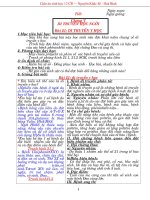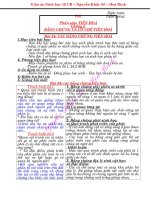nguồn kiến thức bổ sung – prdaily – seo web
Bạn đang xem bản rút gọn của tài liệu. Xem và tải ngay bản đầy đủ của tài liệu tại đây (589.04 KB, 29 trang )
<span class='text_page_counter'>(1)</span><div class='page_container' data-page=1>
15 ways to improve communication in business English
Copyright by Andrew D. Miles and English for Business
www.englishforbusiness.es
</div>
<span class='text_page_counter'>(2)</span><div class='page_container' data-page=2>
15 ways to improve communication in business English
Copyright by Andrew D. Miles and English for Business
www.englishforbusiness.es
15 Ways to
Improve Oral
Communication
in Business
English
C o p y r i g h t b y An d r e w D . M i l e s , B a r c e l o n a , 2 0 1 3 .
A l l r i g h t s r e s e r v e d . N o p a r t o f t h i s p u b l i c a t i o n m a y b e
r e p r o d u c e d , s t o r e d i n a r e t r i e v a l s y s t e m , o r t r a n s m i t t e d ,
i n a n y f o r m w i t h o u t w r i t t e n a u t h o r i z a t i o n f r o m t h e
a u t h o r .
C o v e r p h o t o g r a p h b y A n d r e w D . M i l e s
<b>T h i s i s t h e a b r i d g e d v e r s i o n o f A n d r e w ’ s “ 1 0 1 W a y s t o </b>
<b>I m p r o v e y o u r B u s i n e s s E n g l i s h ” . T h e e b o o k c a n b e b o u g h t </b>
<b>a t www.amazon.es and the printed version at www.profiteditorial.com. </b>
</div>
<span class='text_page_counter'>(3)</span><div class='page_container' data-page=3>
15 ways to improve communication in business English
Copyright by Andrew D. Miles and English for Business
www.englishforbusiness.es
Andrew’s note:
A common mistake is to
think people will be
listening when you say
something important.
In fact, they don’t know
it’s important until
you’ve said it!
<b>1.</b>
<b>INTRO</b>
<b>PHRASES</b>
Use introductory phrases before your
message to catch people’s attention,
so they are listening before you emit
your main point.
This will also let listeners adjust
their hearing to your speed,
pronunciation and tone of voice.
Therefore, they’ll already be used to
your phonemes when you display the
main idea.
EXAMPLES
<i>From my point of view, </i>
<i>this idea is wrong. </i>
</div>
<span class='text_page_counter'>(4)</span><div class='page_container' data-page=4>
15 ways to improve communication in business English
Copyright by Andrew D. Miles and English for Business
www.englishforbusiness.es
<b>1.</b>
<b>INTRO</b>
<b>PHRASES</b>
I’d like to remind you that
From my point of view
Let me tell you that
Apparently
In my opinion
I believe that
It seems that
It appears that
In fact
It sounds as if
Evidently
Seemingly
At first sight
On the face of it
As a matter of fact
Essentially
I’m sure that
</div>
<span class='text_page_counter'>(5)</span><div class='page_container' data-page=5>
15 ways to improve communication in business English
Copyright by Andrew D. Miles and English for Business
www.englishforbusiness.es
Andrew’s note:
Knowing the meaning of expressions is different to being
able to apply them automatically. Vocabulary is not useful
until it’s at the tip of your tongue.
<b>2.</b>
<b>MEMORISING</b>
Memorise key words – since you
will not have time to look for them
when needed.
Knowing the meaning of words is
not enough. They aren’t useful until
you’ve been through the whole
learning cycle. This implies that you
have to understand the word, know
how to use it, memorise it and be
able to recall it when needed.
</div>
<span class='text_page_counter'>(6)</span><div class='page_container' data-page=6>
15 ways to improve communication in business English
Copyright by Andrew D. Miles and English for Business
www.englishforbusiness.es
Andrew’s note:
Transmit a concept more effectively by explaining it, then
giving an example, showing a graph and if possible also by
including it in a story, joke or anecdote.
<b>3.</b>
<b>ONE-IDEA</b>
<b>PHRASES</b>
Use one idea to a sentence and build the
sentence around the idea.
English is a language of few, precise
words where economy is a plus.
Many listeners are used to short
sentences and find it hard to handle
several notions in one phrase.
</div>
<span class='text_page_counter'>(7)</span><div class='page_container' data-page=7>
15 ways to improve communication in business English
Copyright by Andrew D. Miles and English for Business
www.englishforbusiness.es
Andrew’s note:
It’s important to
use gestures
when speaking.
However, act out
your conversation
in front of your
teacher and check
whether your
non-verbal signs
are suitable for
the culture of the
country you are
visiting.
<b>4.</b>
<b>GESTURES</b>
Magnify facial gestures, since they
will help to get your message across
in case verbal language fails and
people don’t follow your words.
Remember that body
language transmits a
lot of information
so don’t be afraid of
gesticulating.
Listeners will take
non-verbal signs as part
of your personality and
will not pay conscious
attention to your gestures.
</div>
<span class='text_page_counter'>(8)</span><div class='page_container' data-page=8>
15 ways to improve communication in business English
Copyright by Andrew D. Miles and English for Business
www.englishforbusiness.es
Andrew’s note:
Remember that if it’s
difficult for you to
speak, it is also difficult
for listeners to
understand. Thus,
give them lots of clues
to help them navigate
your speech.
<b>5.</b>
<b>TOPIC</b>
<b>CHANGE</b>
Give clear clues when you change
subjects so listeners become aware
that you’re no longer talking about
the same issue.
It’s a good idea to remember you
must give listeners a map of your
speech – people must know exactly
where they are standing so they
don’t get lost.
Listeners might be
getting just part of
your message, so
</div>
<span class='text_page_counter'>(9)</span><div class='page_container' data-page=9>
15 ways to improve communication in business English
Copyright by Andrew D. Miles and English for Business
www.englishforbusiness.es
<b>5.</b>
<b>TOPIC</b>
<b>CHANGE</b>
<b>CLUES</b>
SAMPLES
By the way, now we can talk about
I’d like to move onto
Could we now deal with?
Incidentally, may I mention that?
I believe this is the right time to
It has just crossed my mind to
To bring up another subject
An alternative point to consider
Changing subjects, I want to
While we are on the subject
Before I forget
</div>
<span class='text_page_counter'>(10)</span><div class='page_container' data-page=10>
15 ways to improve communication in business English
Copyright by Andrew D. Miles and English for Business
www.englishforbusiness.es
<b>6.</b>
<b> </b>
<b>INTERRUPTING</b>
Interrupting is difficult in a language
that you don’t handle well, because
often when your opportunity comes
you can’t find the right words!
Therefore, it’s essential to learn how
to interrupt with proper expressions.
You will need to use these phrases
without any delay when inserting a
comment or disagreeing with a
statement. Speed is important, as
opportunities to say something rarely
last for long.
</div>
<span class='text_page_counter'>(11)</span><div class='page_container' data-page=11>
15 ways to improve communication in business English
Copyright by Andrew D. Miles and English for Business
www.englishforbusiness.es
<b>6.</b>
<b>INTERRUPTING</b>
Er
Sorry
Actually
Excuse me
May I have a word?
Can I make a comment?
May I come in here?
May I interrupt?
Could I say something?
Sorry, that’s not right.
What are you trying to say?
What are you getting at?
You’re wrong.
Please listen to me.
Can you let me speak?
Won’t you let me give an opinion?
Will you shut up for a minute, please?
+
P
O
L
I
T
E
N
E
S
S
</div>
<span class='text_page_counter'>(12)</span><div class='page_container' data-page=12>
-15 ways to improve communication in business English
Copyright by Andrew D. Miles and English for Business
www.englishforbusiness.es
Steven Pinker, The
Language Instinct,
1994, New York,
Perennial:
English is an
"isolating"
language, which
builds sentences by
rearranging
immutable
word-sized units, like
Dog bites man and
Man bites dog.
Other languages
express who did
what to whom by
modifying nouns
with case affixes,
or by modifying
the verb with
affixes that agree
with subjects in
number, gender,
and person. One
example is Latin,
an "inflecting"
language in which
each affix contains
several pieces of
information.
<b>7.</b>
<b>WORD</b>
<b>ORDER</b>
English is a language
with few inflexions
so order is vital to
establish sense.
Organise words in your
sentences according to
rules, because mixing
priorities will confuse
listeners.
Define a word pattern
and try to apply it to
all your constructions
because even though
</div>
<span class='text_page_counter'>(13)</span><div class='page_container' data-page=13>
15 ways to improve communication in business English
Copyright by Andrew D. Miles and English for Business
www.englishforbusiness.es
<b>7.</b>
<b>WORD</b>
<b>ORDER</b>
<b>Classic word order: </b>
Adverb of time
subject
auxiliary verb
frequency adverb
verb direct object
indirect object
adverb of
manner
adverb of place
adverb of time
SAMPLES
Politicians will sometimes block deals during
election times.
Yesterday, our director asked Mary to finish
her letter by hand at her own desk.
The lawyer wrote the contracts at his office in
</div>
<span class='text_page_counter'>(14)</span><div class='page_container' data-page=14>
15 ways to improve communication in business English
Copyright by Andrew D. Miles and English for Business
www.englishforbusiness.es
Andrew’s
note:
Register is
the type of
language we
use in
specific
situations,
such as
“speaking in
an informal
register” or
“writing in a
scientific
register”.
Andrew’s
note:
We can’t say
at Church
all of what
we say at
the pub!
<b>8.</b>
<b>REGARD</b>
<b>REGISTER</b>
When you learn a
new word, always
ask your teacher for
the context in which
it can be used. Is
it formal? Informal?
Can I use it with friends?
What about writing?
Do not use slang, ironical
expressions or foul
</div>
<span class='text_page_counter'>(15)</span><div class='page_container' data-page=15>
15 ways to improve communication in business English
Copyright by Andrew D. Miles and English for Business
www.englishforbusiness.es
<b>9.</b>
<b> </b>
<b>FILLERS</b>
Resort to fillers for those seconds
you spend looking for words you
can’t find.
Sometimes, you cannot afford to
stay quiet while you plan what
you’re going to say next, so use
fillers to gain time.
FILLERS
Really Clearly
Well OK
Of course Undoubtedly
I believe Certainly
</div>
<span class='text_page_counter'>(16)</span><div class='page_container' data-page=16>
15 ways to improve communication in business English
Copyright by Andrew D. Miles and English for Business
www.englishforbusiness.es
Andrew’s
note:
Always ask
your teacher
how to
pronounce
key words
(for example,
terms related
to your job).
Do not trust
your instinct,
because
pronunciation
is often
unpredictable.
<b>10.</b>
<b>PRONUNCIATION</b>
Memorise difficult words and
practise them often.
When in doubt with names,
ask how to pronounce them
correctly.
Don’t hide your accent by
speaking with your mouth
closed or increasing your
speed, because people will find
it harder to follow you.
</div>
<span class='text_page_counter'>(17)</span><div class='page_container' data-page=17>
15 ways to improve communication in business English
Copyright by Andrew D. Miles and English for Business
www.englishforbusiness.es
<b>10.</b>
<b>PRONUNCIATION</b>
<i>Dow Jones </i> (dou j½nz)
bush (b‹sh)
Finance (f…-n²ns“, fº“n²ns”)
<i>NYSE </i> <i> (µn) (wº) (µs) (¶) </i>
Samuelson (smy-l-sn)
factorage (fktr-ạj)
Keynesian (knzả-n)
leverage <i>(làvr-ạj) </i>
</div>
<span class='text_page_counter'>(18)</span><div class='page_container' data-page=18>
15 ways to improve communication in business English
Copyright by Andrew D. Miles and English for Business
www.englishforbusiness.es
<b>11. QUESTION</b>
<b>TAGS</b>
Apply tail phrases on leading
questions, since they are a legitimate
way to make listeners assert to your
proposals.
Question tags ending with negative
tail phrases elicit affirmative answers.
Question tags ending with positive
tail phrases elicit negative answers.
SAMPLES
This sounds interesting, doesn’t it?
<i>(It elicits an affirmative reply.) </i>
You won’t let a client escape, will you?
</div>
<span class='text_page_counter'>(19)</span><div class='page_container' data-page=19>
15 ways to improve communication in business English
Copyright by Andrew D. Miles and English for Business
www.englishforbusiness.es
<b>12.</b>
<b>FALSE</b>
<b>FRIENDS</b>
Be careful with false
friends, because many
expressions that seem
straightforward to you
can end up messing up
your speech.
Don’t assume that
terms which look like
words in your native
tongue mean the same.
Sometimes, there are
surprises!
Also, some English words that
become part of another language’s
colloquial vocabulary (think of slip
in Spanish) lose their original sense
and end up meaning something else.
</div>
<span class='text_page_counter'>(20)</span><div class='page_container' data-page=20>
15 ways to improve communication in business English
Copyright by Andrew D. Miles and English for Business
www.englishforbusiness.es
<b>12.</b>
<b>FALSE</b>
<b>FRIENDS</b>
FALSE FRIENDS<sub> </sub>
<b>English </b>
<b>Word </b>
<b>Correct </b>
<b>Translation </b>
<i><b>Wrong </b></i>
<i><b>Translation </b></i>
affluent acaudalado <i>afluente </i>
casual informal <i>casual </i>
actual real <i>actual </i>
compromise acuerdo <i>compromiso </i>
comprehensive global <i>comprensivo </i>
familiar conocido <i>familiar </i>
apparent obvio <i>aparente </i>
sensible sensato <i>sensible </i>
COMMONLY MISUSED WORDS<sub> </sub>
parking parking lot or place
mister trainer
basket basketball
</div>
<span class='text_page_counter'>(21)</span><div class='page_container' data-page=21>
15 ways to improve communication in business English
Copyright by Andrew D. Miles and English for Business
www.englishforbusiness.es
Andrew’s
note:
You need
your
teacher’s
help to
improve
intonation. A
good exercise
is for you to
read and for
the tutor to
guide your
tone while
you go
through the
text.
<b>13.</b>
<b>INTONATION</b>
Practise intonation before your
speech, as natives grant
importance to words based on
stress. Remember that every
language’s cadence is
different, so tone variations
applied in Spanish are not
valid for English. Sometimes
listeners will not get the gist of
your sentences if you apply
the wrong intonation patterns.
SAMPLES
<i><b>o Lawyers help company fire victims. (Here the </b></i>
<i><b>stress is on company, so this sentence means </b></i>
<i>that lawyers help the company to dismiss the </i>
<i>employees.) </i>
<i><b>o Lawyers help company fire victims. (Here the </b></i>
</div>
<span class='text_page_counter'>(22)</span><div class='page_container' data-page=22>
15 ways to improve communication in business English
Copyright by Andrew D. Miles and English for Business
www.englishforbusiness.es
Dr Harry Alder & Beryl
Heather, 1999 sustain in
their 1999 NLP textbook
that you can create rapport
by emulating speakers in
body movement, voice tone
and speed. Likewise,
affinity can be encouraged
by following language
styles and type of word
choice, including the
metaphors used.
Andrew’s note:
A good way to improve rapport
is to listen to the other person’s
metaphorical language.
He compares business to rugby?
Use an example from sport. She
talks about cars? Think of a
story that involves driving…
<b>14.</b>
<b> </b>
<b>EMULATE</b>
<b>NATIVES</b>
Emulate native speakers
by listening and then
applying their type of
language in your
phrases, because it is
easier to convince people
employing their own
style of speech.
Politely mimic people
by using the same type
of language. However,
do not copy every
word because this
could prove offensive.
Don’t concentrate so much on your
</div>
<span class='text_page_counter'>(23)</span><div class='page_container' data-page=23>
15 ways to improve communication in business English
Copyright by Andrew D. Miles and English for Business
www.englishforbusiness.es
Andrew’s
note:
Think of
all the
situations you
could use
English for
and list the
phrases you
might need.
Then,
role-play them
with your
teacher.
<b>15.</b>
<b>FUNCTIONS</b>
We use language for different
functions, such as answering the
phone, saying hello or expressing
dissatisfaction.
It is better to learn a few
phrases for every function
than many phrases for a few
functions. Therefore,
instead of memorising
countless ways to ask for
coffee use part of that time
to practise how to book a
room, how to disagree or
how to hire a car.
</div>
<span class='text_page_counter'>(24)</span><div class='page_container' data-page=24>
15 ways to improve communication in business English
Copyright by Andrew D. Miles and English for Business
www.englishforbusiness.es
<b>15.</b>
<b>FUNCTIONS</b>
<b> </b>
<b>A</b>
<b>Please see below a list of phrases </b>
<b>for meetings: </b>
<b>Giving Opinions </b>
I feel that
In my opinion
The way I see things
<b>Asking for Opinions </b>
Heather, can we get your input?
How do you feel about?
What’s your opinion, John?
<b>Commenting on Other Opinions </b>
I never thought about it that way
I get your idea
I see what you mean
<b>Agreeing with Other Opinions </b>
Exactly!
That's just how I feel
I have to agree with James
If you’ve found this
book useful you can
buy the full version
“101 Ways to Improve
Your Business English”
at www.amazon.com
or directly at:
zon.c
om/Improve-Business-
English-Spanish-ebook/dp/B00AHIJQR
8/ref=sr_1_5?ie=UTF
8&qid=1355222923&s
</div>
<span class='text_page_counter'>(25)</span><div class='page_container' data-page=25>
15 ways to improve communication in business English
Copyright by Andrew D. Miles and English for Business
www.englishforbusiness.es
<b>15.</b>
<b>FUNCTIONS</b>
<b> </b>
<b>B</b>
<b>Disagreeing with Other Opinions </b>
Up to a point I agree with you, but
I'm afraid I can’t see it that way
I don’t think so
I’ve got another point of view
<b>Advising and Suggesting </b>
We ought to
Why don't you?
How about
I suggest we
<b>Clarifying </b>
Have I made that clear?
Do you see what I'm getting at?
Let me put this another way
I'd just like to repeat that
<b>Requesting Information </b>
I'd like you to
</div>
<span class='text_page_counter'>(26)</span><div class='page_container' data-page=26>
15 ways to improve communication in business English
Copyright by Andrew D. Miles and English for Business
www.englishforbusiness.es
<b>15.</b>
<b>FUNCTIONS</b>
<b> </b>
<b>C</b>
<b>Connecting Cause and Consequence </b>
This means that…
It implies that …
A results in B.
The measure will cause…
<b>Contrasting </b>
Although A seems fine, B is better because…
In spite of the evidence, I’d like to add that…
We could opt for A. On the other hand…
I like your idea. Nevertheless, I prefer…
<b>Asking for Repetition </b>
Sorry, I didn't catch that
I missed that. Could you repeat it, please?
Could you run that by me again?
<b>Asking for Clarification </b>
I don't quite understand
Could you explain to me how that is going to work?
I don't see what you mean
</div>
<span class='text_page_counter'>(27)</span><div class='page_container' data-page=27>
15 ways to improve communication in business English
Copyright by Andrew D. Miles and English for Business
www.englishforbusiness.es
<b>15.</b>
<b>FUNCTIONS</b>
<b> </b>
<b>D</b>
<b>Stating Purpose </b>
I’m here today to…
What I’d like to do is…
My objective is to…
My aim now is to…
<b>Asking for Verification </b>
Do you mean that?
Is it true that?
Are you sure about this?
Are you one hundred percent positive?
<b>Asking for Spelling </b>
Would you mind spelling that for me, please?
Could you spell it, please?
Sorry, how do you spell it?
<i><b>Is that double m double s? </b></i>
<b>Asking for Contributions from Other Participants </b>
</div>
<span class='text_page_counter'>(28)</span><div class='page_container' data-page=28>
15 ways to improve communication in business English
Copyright by Andrew D. Miles and English for Business
www.englishforbusiness.es
<b>15.</b>
<b>FUNCTIONS</b>
<b> </b>
<b>E</b>
<b>Describing Graphs </b>
I’d like you to see this graph…
Please observe this matrix.
Have a look at this model.
Let me show you a chart.
<b>Correcting Information </b>
Sorry, that might not be quite right
I'm afraid you don't understand
what I'm saying
That's not what I had in mind
This is different to what I meant
<b>Keeping the Meeting on Track </b>
Well, that’s another subject altogether
I'm afraid we can’t discuss that issue today
That's outside the scope of this meeting
Let's get back on track
<b>Finishing the Meeting </b>
Well, that seems to be all the time we have today
Could we make a decision right away?
We’ll have to leave that for now
Time to finish!
</div>
<span class='text_page_counter'>(29)</span><div class='page_container' data-page=29>
15 ways to improve communication in business English
Copyright by Andrew D. Miles and English for Business
www.englishforbusiness.es
A n d r e w D . M i l e s i s t h e d i r e c t o r o f
E n g l i s h f o r B u s i n e s s B a r c e l o n a ,
E n g l i s h f o r B u s i n e s s M a d r i d
E n g l i s h P h o n e a n d t h e B e t t e r E n g l i s h f o r
B u s i n e s s P e o p l e O n l i n e P r o g r a m m e
E n g l i s h f o r B u s i n e s s B a r c e l o n a
t e a c h e s E n g l i s h l e s s o n s t o
c o m p a n i e s i n t h e
B a r c e l o n a a r e a w h i l e
E n g l i s h f o r B u s i n e s s M a d r i d
t e a c h e s E n g l i s h l e s s o n s t o
c o m p a n i e s i n t h e
M a d r i d a r e a .
E n g l i s h P h o n e p r o v i d e s l e s s o n s
b y t e l e p h o n e t o s t u d e n t s w h o
w a n t t o i m p r o v e t h e i r o r a l
c o m m u n i c a t i o n s k i l l s a n d t h e B e t t e r
E n g l i s h p r o g r a m m e o f f e r s b u s i n e s s
E n g l i s h o n l i n e l e s s o n s .
</div>
<!--links-->
<a href=' /><a href='zon.c English-Spanish-ebook/dp/B00AHIJQR8/ref=sr_1_5?ie=UTF8&qid=1355222923&sr=8-5&keywords=101+ways+to+improve+your+business+english'> </a>
<a href=' ebook/dp/B00AHIJQR8/ref=sr_1_5?ie=UTF8&qid=1355222923&sr=8-5&keywords=101+ways+to+improve+your+business+english'>om/Improve-Business- </a>
<a href=' /><a href=' 5&keywords=101+ways+to+improve+your+business+english'> </a>
<a href=' /> Thủ tục khai nộp bổ sung tiền thuế thiếu trong trường hợp không đủ điều kiện khai bổ sung hồ sơ khai thuế theo Điều 34 Luật Quản lý thuế
- 3
- 662
- 0








